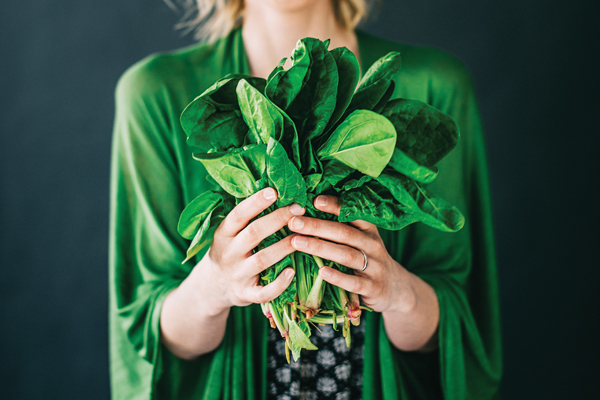What to eat when

Once you find out you’re dining for two, you’re likely to become more mindful of your daily diet. How can you be sure you’re getting the nutrition your peanut needs? It’s simple, really: Load your plate with fruits and vegetables, take a daily prenatal vitamin, and keep an eye on your intake of these top must-eats for expectant moms.
The first trimester
The first trimester can be a tough one for healthy eating because it’s the period of time in which morning (or all-day) sickness usually rears its ugly head. Although it can be hard to hold anything down, Nicole Avena, PhD, research neuroscientist, nutrition expert and author of What to Eat When You’re Pregnant, explains, “During the first trimester, cells are rapidly dividing, making good nutrition vital.” So when you’re able to stomach a snack, focus on delivering these essential vitamins and nutrients to your freshly minted baby …
Folate and folic acid
The most important nutrient to incorporate into your first-trimester diet is a no-brainer—in fact, it’s almost a sure thing that you’ve heard this one before. Folic acid and its naturally occurring sister, folate, are so pertinent to fetal development that doctors encourage all women of childbearing age to make sure they get a healthy daily dose, whether they’re trying for a baby or not.
Avena says that adequate amounts of these vitamins help ensure baby’s proper development—specifically the prevention of neural tube defects that can occur early in pregnancy, as well as the making of DNA, which is obviously a critical step in the beginning stages of fetal growth.
While folate and folic acid serve the same purpose, they aren’t exactly the same thing. Avena explains that folate is the natural form of the B vitamin that is found freely in many foods, while folic acid is the synthetic form that is found in supplements.
“Many of the foods that we consume are fortified with folic acid, such as enriched flours and breads,” says Avena. Check labels while grocery shopping to make sure your pick has been fortified. You’ll also get a healthy dose of folic acid in your daily prenatal vitamin.
Consume plenty of folate, too, which is found abundantly in leafy green vegetables (spinach, kale and dandelion greens), beans (black-eyed peas and pintos), lentils, asparagus, broccoli and citrus fruits.
Zinc
Another nutrient to add to your first-trimester diet: zinc. “[It’s] needed for protein and DNA synthesis,” Avena says. As an additional benefit, zinc is also a great natural immune booster, which can help keep you healthy during a period when most medicines are off the table.
“Just one cup of canned baked beans provides all the zinc you need for one day,” says Avena. You can also find it in beef, lamb, sesame and pumpkin seeds, spinach, asparagus, and shitake and crimini mushrooms.
The second trimester
Although you’ll probably be feeling better and operating with more energy in the second trimester, your body is working harder than ever to put the pieces together for your bambino’s growth. “Make sure you are consuming adequate amounts of protein, iron and fiber,” advises Avena.
Protein
Even when you aren’t expecting, protein is a fundamental part of a healthy diet. Once you’re with child, “Protein is necessary for cell communication and immune function,” says Avena.
Proteins are found in every cell and tissue of the body and play an important part in hormone regulation. They also help regulate appetite and cravings, which can discourage overeating. Remember, you might be eating for two, but one of you is teeny-tiny, so your consumption shouldn’t change significantly.
To get your daily dose of protein, look to beef, chicken and fish. If you abstain from eating meat, find protein in sources such as eggs, dairy (Avena recommends low-fat cheese and yogurt), tofu, quinoa, nuts, beans, hemp and chia seeds.
Iron
An essential component for blood-building, iron is particularly important when you’re growing a human being. In fact, you need 50 percent more than you did prepregnancy to ensure baby’s blood supply is growing strong (and that you have what you need, too).
Mild anemia, which is common in expectant moms, can occur when the
body isn’t receiving enough iron. Although anemia is often harmless outside of leaving you fatigued, it can have some negative effects on your fetus if left untreated, so it does need to be taken seriously.
Additionally, “Iron is important because it is needed to make hemoglobin, which carries oxygen,” says Avena. So on top of its blood-creating capabilities, it’s also fundamental in guaranteeing that oxygen is moving from your lungs to the rest of your body and to the body of your budding babe.
There are two types of iron: heme iron, which is found in beef, chicken, turkey and pork (and is the type your body absorbs best), and nonheme iron, which you can find in beans (kidney, lima and soy), tofu, spinach, raisins and iron-fortified cereals and oatmeal. If you’re a fan of orange juice, pour a glass when you sit down to a meal that contains nonheme iron: Vitamin C has been shown to help your body absorb it.
Fiber
Last but not least on the second-trimester list is fiber. “Fiber is helpful for those who experience constipation during the second trimester due to hormonal shifts,” says Avena. However, she warns that you should add plenty of water to your diet, too, so the H2O and fiber can work together.
To find fiber, make bran your new best friend. Sprinkle it on cereal, and add it to pancakes. Beans are also a good source of fiber, along with berries, whole grains, legumes, leafy greens and apples (skin on).
The third trimester
No surprise here: Your healthy diet should carry into the third trimester. You’re in the homestretch, so baby’s body is getting its finishing touches, which are just as important as the building blocks of the beginning.
Omega-3 fatty acids
First up: “Consuming adequate amounts of the omega-3 fatty acids EPA and DHA during the third trimester is necessary to support brain development and vision,” says Avena. “High maternal DHA levels are associated with higher cognitive function, as well as decreased risk of allergies.”
EPA and DHA are long-chain omega-3 fatty acids—essential pieces of the pies that are shaping up to be your baby’s cell membranes, brain and eyes. DHA is one of the most prevalent fatty acids in the brain and retina, and both EPA and DHA may also decrease your risk of preterm labor.
Fatty fish—such as anchovies, salmon and tuna—are a great source of omega-3s, as is grass-fed beef. Flaxseed oil and edamame are other natural sources. You can also find omega-3-fortified eggs, milk, bread and peanut butter.
Calcium
Your wee one’s calcium absorption ramps up in the third trimester. “[Calcium] is needed for the development of the baby’s teeth and bones, as well as a healthy nervous system and muscle growth,” explains Avena. If you don’t consume sufficient calcium, baby will make sure she’s getting enough by taking it from her mama’s bones (which is good for her, but not so much for you).
Calcium is also important for building nerves and muscles, helping develop a normal heart rhythm and offering up blood-clotting abilities. Milk and other dairy products are primary sources of calcium, but you can also find it in sardines, leafy greens and fortified orange juice.
Although the suggestions here highlight what’s most critical in each trimester, they don’t mean you should wait until trimester two to worry about protein or trimester three to focus on calcium. All of these nutrients are important at each stage of pregnancy, and it’s never too early to add them in. Strive for a healthy diet from day one to provide you and your baby the optimal nutrition you both need and deserve.







